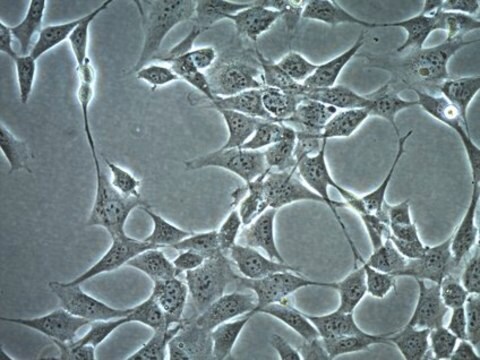SCC049
O9-1 Mouse Cranial Neural Crest Cell Line
Mouse
Synonym(e):
Multipotent mesenchymal cells
About This Item
Empfohlene Produkte
product name
O9-1 Mouse Cranial Neural Crest Cell Line, stably expresses stem cell markers and neural crest markers
Biologische Quelle
mouse
Qualitätsniveau
Methode(n)
cell culture | stem cell: suitable
Versandbedingung
liquid nitrogen
Allgemeine Beschreibung
Whole-genome expression profiling of O9-1 cells revealed that this line stably expresses stem cell markers (CD44, Sca-1, and Bmi1) and neural crest markers (AP-2a, Twist1, Sox9, Myc, Ets1, Dlx1, Dlx2, Crabp1, Epha2, and Itgb1). O9-1 cells are capable of contributing to cranial mesenchymal (osteoblast and smooth muscle) neural crest fates when injected into E13.5 mouse cranial tissue explants and chicken embryos. These results suggest that O9-1 cells represent multipotent mesenchymal cranial neural crest cells. The O9-1 cell line should serve as a useful tool for investigating the molecular properties of differentiating cranial neural crest cells. The O9-1 cell line can be propagated and passaged for at least 10 passages, and can differentiate into osteoblasts, chondrocytes, smooth muscle cells, and glial cells (Ishii, 2012).
Ishii, M., et al. (2012) A stable cranial neural crest cell line from mouse. Stem Cells Dev. 21(17): 3069-3080.
Beschreibung der Zelllinie
Anwendung
Neurowissenschaft
Stammzellforschung
Komponenten
Qualität
• Cells tested negative for infectious disease by a murine PCR panel (Mouse Essential CLEAR Panel by Charles River Animal Diagnostic Services)
• Cells tested negative for mycoplasma contamination
Physikalische Form
Lagerung und Haltbarkeit
Lagerklassenschlüssel
10 - Combustible liquids
WGK
WGK 1
Flammpunkt (°F)
Not applicable
Flammpunkt (°C)
Not applicable
Analysenzertifikate (COA)
Suchen Sie nach Analysenzertifikate (COA), indem Sie die Lot-/Chargennummer des Produkts eingeben. Lot- und Chargennummern sind auf dem Produktetikett hinter den Wörtern ‘Lot’ oder ‘Batch’ (Lot oder Charge) zu finden.
Besitzen Sie dieses Produkt bereits?
In der Dokumentenbibliothek finden Sie die Dokumentation zu den Produkten, die Sie kürzlich erworben haben.
Artikel
Products to enable the creation of neural models specific for your research.
Protokolle
Step-by-step culture protocols for neural stem cell culture including NSC isolation, expansion, differentiation and characterization.
Unser Team von Wissenschaftlern verfügt über Erfahrung in allen Forschungsbereichen einschließlich Life Science, Materialwissenschaften, chemischer Synthese, Chromatographie, Analytik und vielen mehr..
Setzen Sie sich mit dem technischen Dienst in Verbindung.